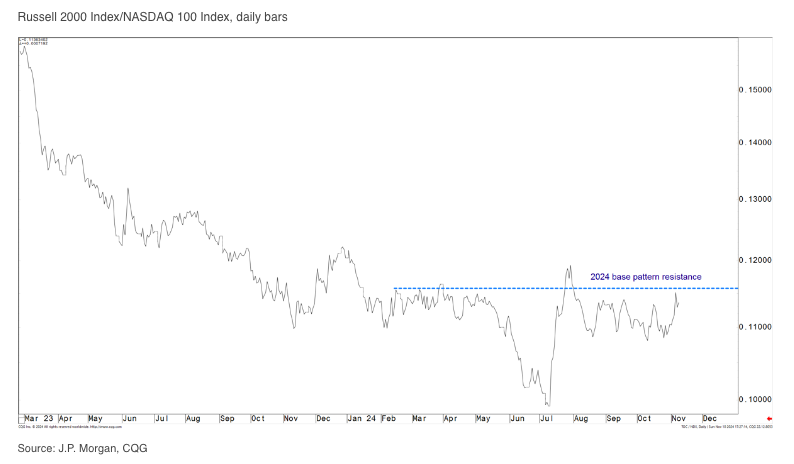The Russell 2000 Index has been showing signs of life in 2024, breaking out from a long-standing base and closing in on targets near 2450.
According to JPMorgan analyst Jason Hunter, small-cap stocks may finally be ready to outperform their mega-cap tech peers. This may be good news for investors in the iShares Core S&P Small-Cap ETF IJR, the iShares Russell 2000 ETF IWM and the Vanguard Small Cap ETF VB
But will this shift be the dawn of a new era, or just a fleeting moment in the spotlight?
Read Also: Russell 2000 Poised For Major Technical Breakout: Analyst Eyes ‘A Trend Reversal In Favor Of Small Caps Outperforming’ S&P 500
Russell 2000 Sets Bullish Targets
Hunter points to a “bullish pattern progression” forming in 2024 as the Russell 2000 climbed from a multi-quarter base. Small caps have broken through the 2282-2299 resistance zone, making 2432-2486 the next short-term goal, and the move has shown no signs of losing steam yet. The recent rally in small-cap stocks, especially in the Russell 2000 Index, seems to be moving closer to 2021 cycle highs, which could mean a big shift in market dynamics.
For now, the index stays decisively bullish. As long as it holds above the 2260 post-election breakaway gap, Hunter sees the bulls maintaining control, with potential support anchored around the 2100s, courtesy of the 200-day moving average and October’s breakout zone.
Small Cap Vs. NASDAQ 100: A New Market Leader?
According to Hunter, the Russell 2000’s recent moves aren’t just about technical strength – they’re about a potential regime change.

The ratio of the Russell 2000 to the NASDAQ 100 is flirting with key resistance levels. A breakout here would confirm that small caps are set to lead, while big tech, which has dominated for two years, may start to lag.
Hunter calls this a “tentative rotation to more cyclically sensitive groups.” This trend, he believes, could continue into 2025 if the Russell/NASDAQ ratio breaks out decisively this quarter.
What’s Driving Small-Cap Strength?
Even before the election-driven rally in U.S. equities, post-September FOMC price action had already put a bullish wind at the back of small caps. Hunter notes that small caps have consistently held key supports, including the October channel and moving averages, creating a setup for continued gains.
The Russell 2000’s next targets include 2585, derived from the recent ascending triangle pattern. If the index clears these levels, it could signal a more sustainable trend favoring cyclicals over mega-cap tech. But a reversal back below these supports could be a sign that the small-cap rally is just a temporary phenomenon.
Cyclicals In Control – For Now
Hunter’s outlook stays cautiously optimistic, but he warns that the future performance of small caps versus tech hinges on whether they can maintain these breakout levels. While he sees continued bullish momentum into early 2025, Hunter emphasizes that tracking the Russell/NASDAQ ratio is key to confirming any real change in market leadership.
If this trend holds, 2024 could mark a major shift back to small caps and cyclicals. For now, though, it’s up to the Russell 2000 to prove this rally is more than a fleeting burst of strength.
Read Next:
Image:
Market News and Data brought to you by Benzinga APIs